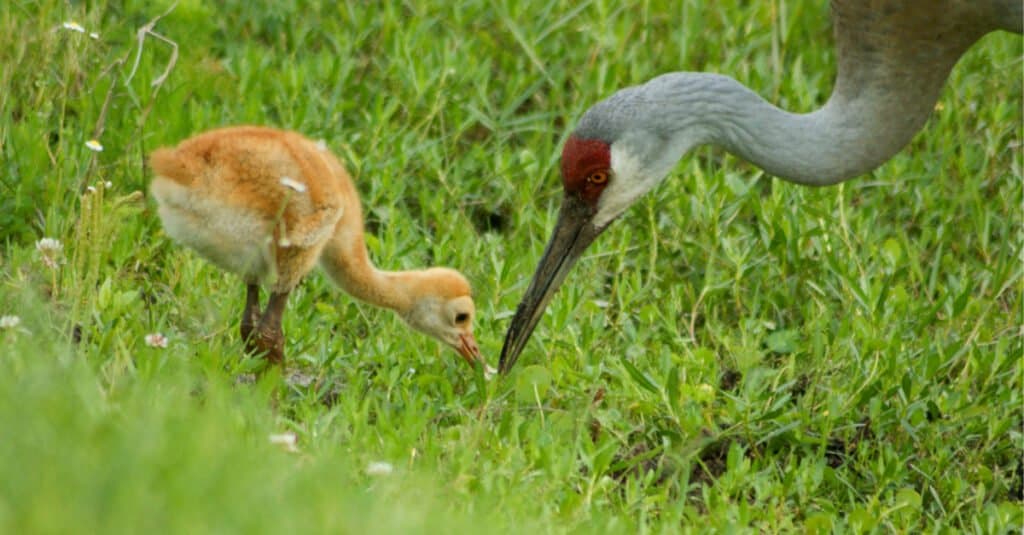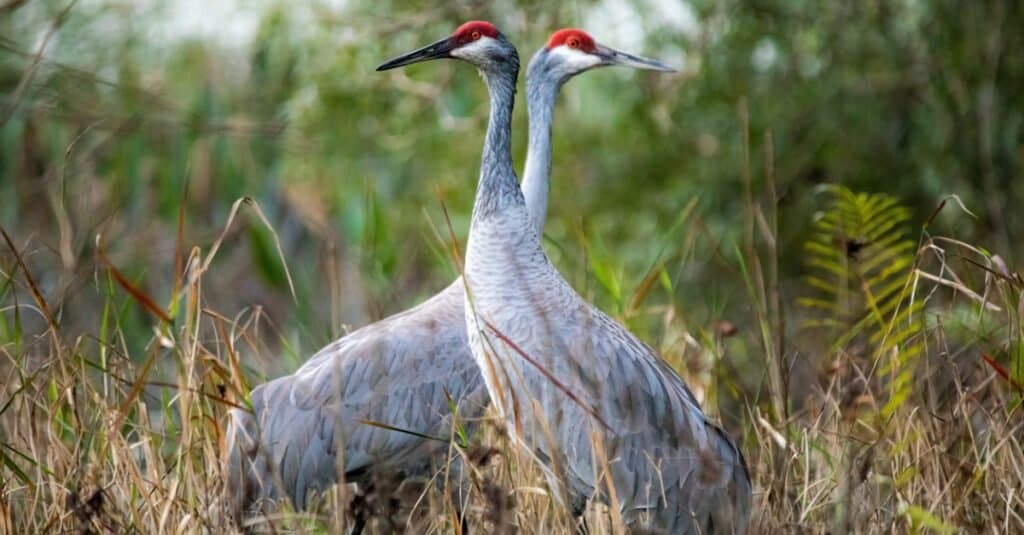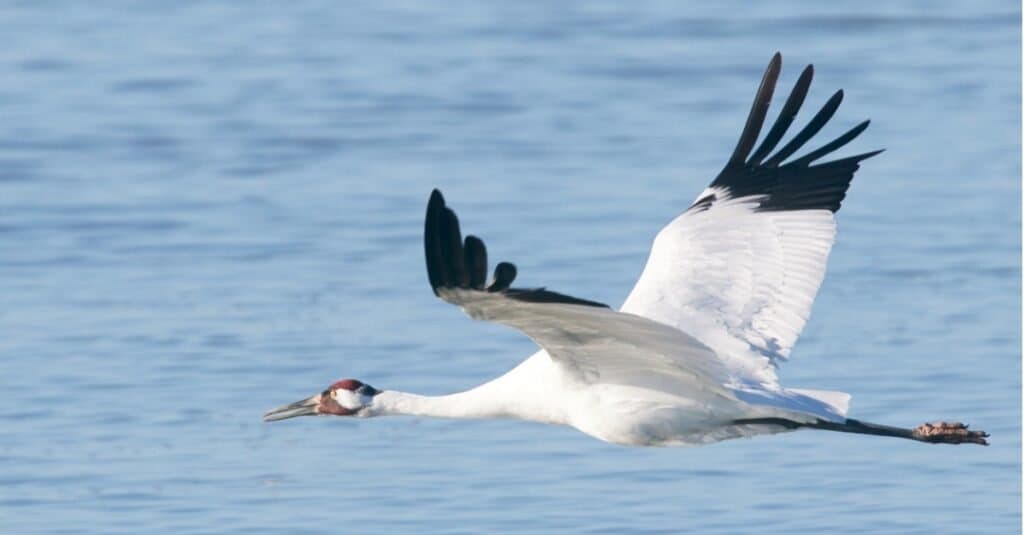Did you know that sandhill cranes have lived for over two million years? This is why sandhill cranes are considered prehistoric birds, with the species believed to have originated 2.5 million years ago. Sandhill cranes are majestic bird creatures that inhabit freshwater wetlands, marshes, and other areas with stagnant water and abundant vegetation. One of the most beautiful events in marshlands is witnessing numerous sedges of cranes converge in one river basin to rest, eat, and migrate.
You might be wondering what cranes are eating as they continuously dig their bills on the surface of their habitat. Below, we will dive into what food sandhill cranes like to eat.
What Do Sandhill Cranes Eat?

Sandhill cranes are omnivores that eat seeds, nuts, snakes, and rodents
©iStock.com/Bkamprath
As omnivores, sandhill cranes eat a variety of food that include plants, seeds, nuts, grains, roots, crops, fruits, insects, snails, snakes, lizards, frogs, fish, rodents, and birds.
Sandhill cranes prefer plants when they are readily and widely available, but they are opportunistic feeders, so their food selection can vary depending on what choices are available for them.
As sandhill cranes prefer vegetation, they eat these foods as primary part of their diet:
- Bread
- Fruits
- Peanuts
- Berries
- Sunflower seeds
- Bird seeds
- Plant tubers
- Grains
- Roots
- Corn
- Cottonseed
- Wheat
- Acorns
- Nuts
- Sorghum
- Cultivated crops
Sandhill cranes dig and poke with their bills in search of seeds, berries, and roots. When preparing for migration, sandhill cranes rely heavily on waste corn to supplement their nutrition.
What Animals Do Sandhill Cranes Eat?

Sandhill cranes feed on cold-blooded animals like fish, frogs, and lizards.
©iStock.com/Bkamprath
Beyond their plant diet, sandhill cranes eat a plethora of animal species, from insects, to small mammals, down to amphibians, and reptiles.
While sandhill cranes generally eat plants, when food is low, they will eat just about anything that is available, which makes them omnivores. In their usual habitat, sandhill cranes often feed on cold-blooded animals, such as:
- Insects
- Fish
- Crayfish
- Snakes
- Frogs
- Lizards
- Snails
- Ants
- Grubs
- Grasshoppers
- Mealworms
- Earthworms
- Bugs
Sandhill cranes, in contrast to other wading birds, such as herons, do not engage in “fishing.” Breeding cranes are more likely than non-breeding ones to prey on insects, snails, frogs, small mammals, reptiles, and other invertebrates, among other things. Although they generally do not normally consume tiny birds and baby ducks, they are capable of doing so.
Sandhill cranes do not hunt, but they forage for food by gleaning from the surface of their habitat and probing bottoms of soft soils, mud, or marshes with their bills.
However, sandhill cranes also include small mammals and birds in their diet, those whose size are small enough for them to swallow. The warm-blooded animals sandhill cranes eat include:
How Much Do Sandhill Cranes Eat?

Sandhill cranes eat close to 400 kernels of corn each day.
©iStock.com/GummyBone
Given their size and weight, sandhill cranes can eat a hefty meal. During the spring season, sandhill cranes feed on approximately 400 kernels of corn per day.
Sandhill cranes can grow to be fairly huge, standing over 4 feet in height, and generally weighing between 7 to 11 pounds, with the largest sandhills reaching nearly 15 pounds. That is pretty hefty for a flighted bird of that size. Flight for sandhill cranes is accomplished via their enormous wings, which may measure up to 7.5 feet in width.
How Do Sandhill Cranes Search for Food?
Sandhill cranes usually do not have any difficulty locating food because they are able to consume practically any type of food in the natural environment. It is common for them to feed with their bills down to the ground as they rummage around for seeds and other meals in shallow marshes with plants, or in a variety of upland environments.
Some homes, gardens, or backyards that are near areas of sandhill crane habitats can often encounter these cranes uninvited. The presence of a lovely yard and garden, as well as numerous bird feeders and bird baths, appears to attract them well.
Almost all of the sandhill cranes are found in North America, but each subspecies has a different area. They can be found all over Canada, where there are a lot of breeding populations. During the winter, a lot of different species move to the United States and Mexico. When breeding, Sandhill cranes tend to prey on meat and other living animals.
What Eats Sandhill Cranes?
Various predators, such as foxes, raccoons, and coyotes, are known to prey on eggs and young sandhill cranes.
Adult sandhill cranes are normally able to flee from these predators, although they are unable to do so from huge birds of prey like golden eagles. Predators are kept at bay by the sandhill crane’s aggressive disposition, massive size, and ability to fly.
When sandhill cranes reach within striking distance of a predator, the cranes leap at the predator and strike it with their feet. When threatened by other predators, the sandhill cranes respond by expanding their wings in front of them and aiming their bill to indicate a threat. They fight the predator with their bills, hissing and piercing them, then striking them with their feet if hissing and stabbing with their bills do not work.
Can Humans Feed Sandhill Cranes?
Sandhill cranes in Florida live in natural habitats that are replete with their food, such as insects and tiny animals, so they do not require human assistance in order to survive and reproduce in the wild. The intentional feeding of cranes by people is fraught with danger for a variety of reasons.
When people use food to attract sandhill cranes, they may unintentionally endanger the birds’ lives. The Florida Fish and Wildlife Conservation Commission specifically made it illegal to deliberately feed sandhill cranes in 2002, citing public safety concerns.
After being fed and learning to identify human food, sandhill cranes may be able to overcome their fear of humans. People may be approached by these cranes, and may even take food from a person’s hand. Cranes have been observed to peck people on occasion, but this is quite rare.
What Types of Cranes Are There?

The
whooping crane
is one of 15 species of cranes distributed across the planet.
©iStock.com/kellington1
There are a total of 15 species of cranes worldwide. Many of these birds have scattered distributions, with location shifting when they migrate seasonally. Below is a list of the different species including where they are located:
- Eurasian (Common) Crane – Europe, Asia, Africa
- Sandhill Crane – North America, Africa
- Demoiselle Crane – Africa, Russia, Ukraine, Central & East Asia
- Blue Crane – Africa
- Wattled Crane – Africa
- Siberian Crane – Siberia, China, Iran
- Hooded Crane – Russia, China, Japan, Korea
- Whooping Crane – Canada, United States
- Black Crowned Crane – West Africa
- Grey Crowned Crane – Southern & East Africa
- Sarus Crane – Pakistan, India, Nepal, Australia, Indochina
- Brolga, Australian Crane – Australia & New Guinea
- White Naped Crane – Japan, China, Korea, Mongolia
- Red-Crowned Crane – Japan, China, Russia
- Black-Necked Crane – India, China
The photo featured at the top of this post is © Tom Zeman/Shutterstock.com
Thank you for reading! Have some feedback for us? Contact the AZ Animals editorial team.






